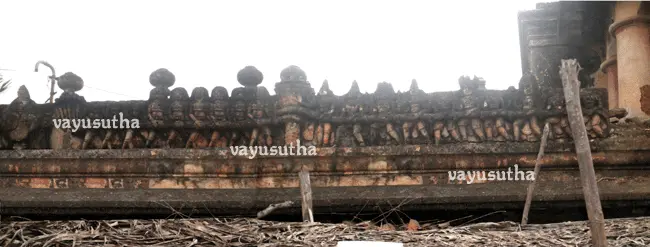
Karuthattankudi
Karuthattankudi is a place on the outskirts of Thanjavur that one encounters just after crossing the river Vadavaru on the Kumbakonam-Thanjavur route. The place is between two rivers north of Vadavaru and south of Vennaru. The place originally known as Karunthittaikkudi is presently known as Karuthattankudi and in short as ‘karanthai’. Historians believe that this place is older than Thanjavur. In ancient scriptures, Karanthai lies on the Highway connecting Thanjavur and Thiruvaiyaru which is referred to as ‘Kotivanamudaiyal Peruvazhi’ [கோடிவனமுடையாள் பெருவழி].
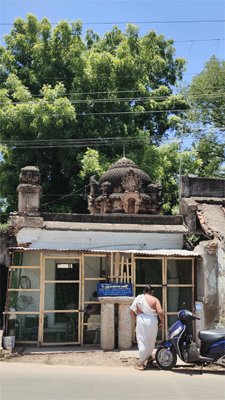 The compilation of hymns sung by great Saivet saints on Lord Shiva is known as Thevaram. The place where the presiding deity is sung by such great saints is known as ‘paadal Petra sthalam’. If the presiding deity of another place is referred to in Thevaram of ‘paadal Petra sthalam’ then such place is known as ‘vaippu sthalam’. Karuthattankudi has one such ‘vaippu sthalam’, known as Sri KarunaSwamy temple. The presiding deity is known by three names Vasishteswarar, Karunaswamy, and Karuvelayuthaswamy. Sri Appar Swamigal had mentioned this temple in the 6th Thirumurai 71st Pathikam 3rd hymn.
The compilation of hymns sung by great Saivet saints on Lord Shiva is known as Thevaram. The place where the presiding deity is sung by such great saints is known as ‘paadal Petra sthalam’. If the presiding deity of another place is referred to in Thevaram of ‘paadal Petra sthalam’ then such place is known as ‘vaippu sthalam’. Karuthattankudi has one such ‘vaippu sthalam’, known as Sri KarunaSwamy temple. The presiding deity is known by three names Vasishteswarar, Karunaswamy, and Karuvelayuthaswamy. Sri Appar Swamigal had mentioned this temple in the 6th Thirumurai 71st Pathikam 3rd hymn.
It is no wonder that later saints like Sri Bhikkaji Bava Shahapurkar alias Bhimaraja Swamy direct disciple of Sri Samarth Ramadas had chosen Karanthai as their last resting place.
Thanjavur the host city
It is a common practice for South Indians to visit Kasi [Varanasi] in the North and pilgrims from North India to visit Rameswaram in the South. Many towns between these two pilgrim centers had hosted those pilgrims with food and staying facilities. Apart from these pilgrims, scholars were also travelling from South India to North India and vice versa. Thanjavur during those periods was one such hosting town.
Chatrams and Mutts
The place where the facility for staying and providing food for the pilgrims and scholars was extended was known as choultry or chatram. Chatrams are a wayside resting place with food. If such a chatram is established by a saint to preach the philosophy of his or his revered saint, it is called madam. Normally a deity of their choice is also installed and worshiped in such mutts.
The said inscription has been found in the sannidhi of Sri Maruti which is located on the South-East corner of the main Sri Rama temple. Today this temple is accessible from the main road itself. There are two idols of Sri Maruti present in this temple sannidhi. It could be believed that one of the idols could have come here when some displacement took place elsewhere.
Many such saints visit these holy kshetras in pursuit of this goal of attainment of ‘moksha’. They were also known as Bairahi or Bairagi and the word is derived from the word ‘vairahi’ which means ‘people living with a vow’. Some of these saints who travelled to south India as a part of this holy trip had decided to settle down in various places in South India. Few of them had built chatram for other visitors from their place of origin. Many rulers patronised these philanthropical activities.
Maratha kingdom of Thanjavur
The Thanjavur was under the rule of Nayaks when Marathas overthrew them and took over the kingdom. Venkoji, the half-brother of Maratha king Shivaji was the first King of Thanjavur. Then the Maratha rule continued till the British intervened to bring the territory under the paramountcy of the British.
Maratha’s contribution
All the kings of Marathas were patronage of music and other fine arts. Besides, their charities were liberal and mainly directed towards the feeding of the poor. All the kings had maintained and increased the charities repaired temples, tanks were dug, and choultries (chatram) were built. Many chatrams were feeding the poor and many of them were given education at these chatrams. Scholarships for skills in music and art were encouraged. It is by no means a little achievement given the financial strains under which the administration was at those times.
It was during the Maratha rule the ‘bhakti movement’ took shape. The movement was characterised by several elements like the construction of new temples, encouragement, and royal sponsorship for several artistic oeuvres in the form of classical music, dance, and iconographic paintings. One of the most important components of this movement was the genesis of a South Indian format for the Bhajana Sampradaya.
Dhanakadhaarii baba Mutt [धनकधारी बाबा]
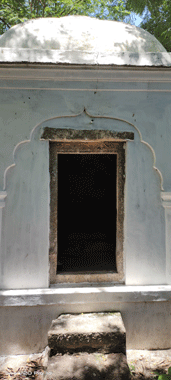 One such mutt established during Serfoji II is located in Karuthattankudi. It has come to light that the mutt was established during Serfoji II time. The stone inscription in Marathi found in the premises of the sannidhi of Sri Anjaneya in the mutt was decoded for the first time by this author. The transcript of the inscription reads to state the following:
One such mutt established during Serfoji II is located in Karuthattankudi. It has come to light that the mutt was established during Serfoji II time. The stone inscription in Marathi found in the premises of the sannidhi of Sri Anjaneya in the mutt was decoded for the first time by this author. The transcript of the inscription reads to state the following:
‘Srimath Chatrapathi Sarabendra maharaja had ordained on Saka year 1742 (corresponding to 1820 CE) [Hindu year] Vikrama year Tai month 27th day that Dhanakadhaari bava mutt to establish a temple for Sri Ramachandra and Maruti. This grant has been made for the conduct of Puja, Neivedyam, and the distribution of prasadam to the pilgrims and Bairahis forever. [For this purpose] shops and houses can be constructed, manufacture of fireworks is permitted. This [Distribution of prasadam] has to be continued by the Dhanakadhaari and his disciples.’
Apart from this inscription, other Marathi modi documents stating the contributions made by the royals to this mutt are also available. One of the documents is about the quantum of grains and Ghee that the mutt had to get from the ‘vinnatrnkarai anna chatram’. Another document states the contribution of the royals to the Vinayaka Chaturthi celebration. There is a document stating the cash given to the mutt and cash for the construction of mandapam for the temple.
From all these, it could be well said that during the Serfoji II period, the mutt as well as the temple was well taken care of.
Pattabhisheka Sri Kodanda Swamy temple
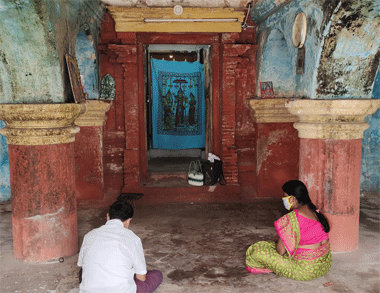 The temple is located in Karuthattankudi just after crossing the river Vadavaru Bridge on the left side while coming from Thanjavur. The façade of this temple could be seen all along the top of the more visible shops. An excellent mortar mold artwork of ‘ksheera sagara madhanam’ could be seen, which is at present in bad shape. In the center of the façade is the entrance, with an arch depicting the SriRama Pattabhisheka scene done in mortar mold [stucco figure].
The temple is located in Karuthattankudi just after crossing the river Vadavaru Bridge on the left side while coming from Thanjavur. The façade of this temple could be seen all along the top of the more visible shops. An excellent mortar mold artwork of ‘ksheera sagara madhanam’ could be seen, which is at present in bad shape. In the center of the façade is the entrance, with an arch depicting the SriRama Pattabhisheka scene done in mortar mold [stucco figure].
After entering through the arch, one comes across muka mandapam, then the [mun] front mandapam, then artha mandapam then garbhagraham. All the mandapams are on gorgeous and elegant pillars. On top of the front mandapam, is an arch showing the Vaishnava symbol along with Shankha and Chakra in mortar mold. The main deity Sri Rama along with His consort Sita on His right, Lakshmana on the left with Sri Maruti on the right side is housed in the Sanctum sanctorum. The idols are made of ‘shaligram’ reflecting the serenity, composure, and tranquility of these divines. Concourse for making circumambulate of the gharbhagraha is present so that devotees can make ‘pradhkshanam’ of the main deity.
On the southern side of the temple adjacent to the Vadavaru one could see the adhishtanam of the saints of this mutt.
When I first went inside the temple and saw Swami darshan, at first I forgot myself, the magnificent Sri Rama Murthy Darshan and the Samadhi mandapam of the Siddha Purushas, the serene environment. I regret not visiting this magnificent temple earlier, although I was passing through this way looking only at the dilapidated exterior appearance of the temple.
Temple for Sri Maruti
Originally two separate temples for Sri Maruti had been built by the mutt. The first Maruti temple is on the south end of the main temple complex and the other is on the north end of the temple complex. To give access to Uma Maheshwara Higher Secondary School from the main road itself, the north end of Maruti temple had been shifted westwards and devotees could visit the temple from the adjacent side road.
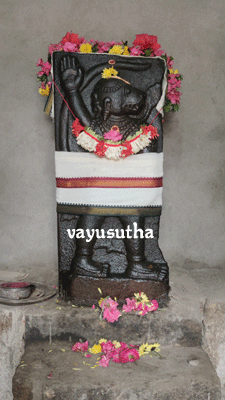 It is worth noting the above-said inscription has been found in the sannidhi of Sri Maruti which is located on the South-East corner of the main Sri Rama temple. Today this temple is accessible from the main road itself. There are two idols of Sri Maruti present in this temple sannidhi. It could be believed that one of the idols could have come here when some displacement took place elsewhere.
It is worth noting the above-said inscription has been found in the sannidhi of Sri Maruti which is located on the South-East corner of the main Sri Rama temple. Today this temple is accessible from the main road itself. There are two idols of Sri Maruti present in this temple sannidhi. It could be believed that one of the idols could have come here when some displacement took place elsewhere.
The deity of Sri Maruti in south end temple is given in this page.
Sri Maruti
The idol of Sri Maruti made of granite stone is about four feet in height, in an embossed format known as ‘ardha shila’ facing east.
Sri Maruti is in walking posture. His left lotus foot is seen in the front and His right lotus foot is firmly on the ground. Both His feet are adorned with nupuram and thandai. He is wearing a dhoti in a katcham style, held by the tightly twisted cloth going around the waist thrice. His left hand is seen near the left hip, holding the stem of the sowgandika flower. The flower is seen above His left shoulder. Bracelet on the wrist and nupuram on the upper arm is seen. He is wearing three malas close to His neck. Another mala adorns His bosom. Lord is wearing yagnopaveetham and uttariyam. ‘Bhuja valayam’ adorns his shoulders. With His right hand raised above He showers ‘nirbhathvam’ [blessings] on His devotees. The Lord is wearing kundal in His ears. His kesam is neatly tied into a tuft held by an ornate ‘kesa-bhada’. The tail of the Lord is raised above His head. The fluffy cheek and ‘korapal’ give confidence to devotees that He is there to protect them. His lustrous eyes emit karuna on the devotee.
Location of the temple: "Sri Maruti temple, Dhanakadhaarii baba Mutt, Karuthattankudi"
Experience
In the serene environment of the temple housing adhishtana of saints and the Darshan of Pattabhisheka Sri Ramachandra Murthy will make one spellbound and the darshan of His dasa Sri Maruti will captivate the mind. Visit to this kshetra is sure to quienten the mind bring peace to the thought.
SRI HANUMAN THINKS DIFFERENTLY, THINKS FAST
THINKS AHEAD AND ACTS FOR SURE
Ed [January 2022]
Updates: [Jan 2025]
* about the author see 'Briefs on Authors'
